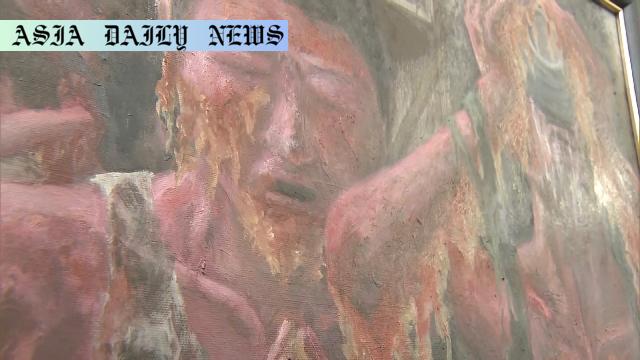Hibakusha: Japanese students create artworks based on atomic-bomb survivor accounts to preserve historic memories for future generations.
- Japanese high school students created artworks inspired by six hibakusha survivors’ accounts.
- The initiative preserves Hiroshima’s atomic bomb legacy for future generations.
- The pieces will be displayed at Hiroshima’s Peace Memorial Park in August.

Artistic Initiative to Safeguard the Memories of the Hibakusha
In Hiroshima, a group of high school students has taken an extraordinary step to immortalize the accounts of atomic-bomb survivors, known as hibakusha, through the lens of art. This annual initiative, organized by Motomachi High School, engages students to create visual representations based on the detailed testimonies of survivors who endured one of the most catastrophic events in world history. The selected themes and their artistic reinterpretations resonate with a commitment towards promoting peace and ensuring future generations understand the harrowing consequences of nuclear warfare.
This year marked the creation of 15 powerful pieces of art, each uniquely inspired by six hibakusha accounts. Among these, the work of Hashimoto Ichigo, a third-year student, stands out. Her painting draws upon the heartbreaking memories of Shingo Naito, an 86-year-old survivor who experienced devastating personal losses following the atomic bombing. Through meticulous attention to detail, Hashimoto captured the desperation of Naito as he led his blinded father to a first-aid center—a vivid depiction of resilience amidst despair. This story, along with others presented, serves as a poignant reminder of the human cost of war.
Empathy and Education Through Art
Art has often been the bridge between distant narratives and present realities, and these artworks from Hiroshima high school students demonstrate its power to educate and inspire empathy. By engaging deeply with survivor testimonies, students were able to illustrate not just the immediate impact of the atomic bombing, but also the enduring emotional scars borne by the hibakusha. For example, Ichigo’s portrayal of Naito’s mother carrying his younger siblings speaks volumes about the sacrifices and determination of those who survived.
These works collectively encapsulate the indescribable struggles faced by hibakusha. At the same time, they are unflinching in their message—provoking discussions about peace and the necessary steps humanity must take to avoid repeating mistakes of such magnitude. Bringing these stories to life through art channels both education and advocacy, ensuring that the memories of Hiroshima remain etched in the conscience of future generations.
Exhibiting the Past to Illuminate the Future
The completed artworks are set to be displayed at the International Conference Center Hiroshima within the Peace Memorial Park, from August 6 to 20. This exhibition highlights not just the talent of the students, but also honors the courage of hibakusha who shared their painful memories. The stories captured in the artworks showcase not only survival but resilience, offering invaluable lessons in hope and determination.
These paintings act as a historical testament, ensuring that the voices of hibakusha are neither forgotten nor drowned by the passage of time. The Peace Memorial Park serves as the perfect venue, as its very existence is dedicated to advocating for a world free from nuclear weapons. By tying education, art, and memory together, this initiative raises critical awareness among both local and international visitors.
A Legacy of Peace and Reflection
The initiative undertaken by Motomachi High School students represents more than a simple art project; it symbolizes an act of stewardship. As hibakusha age and fewer firsthand accounts remain, the responsibility to carry forward their legacy becomes greater than ever. These artworks are a powerful medium through which the message of peace can be conveyed across linguistic and cultural barriers.
The hibakusha have borne the weight of unimaginable losses, but by sharing their experiences and allowing newer generations to represent them, they have succeeded in transforming their pain into a call for global change. This bond between survivors and the younger generation holds immense promise, ensuring that their memories act not as a relic of the past but as a living guide for humanity’s future.



Commentary
Preserving Memory Through Art
The efforts of Japanese high school students to depict the stories of hibakusha are not just commendable; they are profound acts of preservation. In a world that often struggles to reconcile with its dark historical events, initiatives like these remind us of the importance of remembrance. By putting paintbrush to canvas, these students have contributed not only to local history but to a global narrative advocating for peace. It is challenging to fully comprehend the scope of what survivors endured, but art succeeds where words sometimes fail in encapsulating emotions.
Empathy as a Tool for Education
The students’ work also underscores the importance of empathy in education. By interacting directly with survivors and translating their experiences into powerful visuals, these young individuals have engaged with history on an emotional level. Such initiatives encourage critical thinking and empathy—not just as academic exercises but as transformative experiences. For visitors to see these works on display, the visual impact magnifies the real, human cost of the atomic bomb—a lesson no textbook can convey with the same potency.
Beyond Art: A Call for Action
Ultimately, these artworks serve as more than aesthetic or educational pieces; they are calls to action. In highlighting the resilience of hibakusha, they challenge us to consider our responsibility in fostering a peaceful world. As these pieces are displayed in Hiroshima’s Peace Memorial Park, they add to the discourse on nuclear disarmament and the necessity of avoiding future conflicts. Through these artistic expressions, the students amplify a message that must not be ignored.